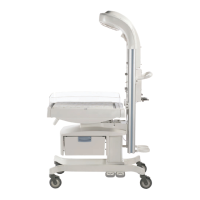Appendix D: Troubleshooting
Service Mode (Application Software 1.0.9 and Earlier)
Service Manual D-5
3. To stop/start capture select Transfer from the main HyperTerminal Screen.
Data received via the “LOGS” command will contain multiple entries formatted in the following fashion:
The first four sections (Date, Time, Temperature, Log Type) are consistent for every entry and have the
following values:
Date The Date the log entry occurred.
Time The Time the log entry occurred.
Temperature A reading of a thermistor placed on the surface of the control board.
Log Type Can be one of the following values:
“POW_UP” Denotes a log entry indicating the system was powered up.
“BUT_PUSH” Captured information about a button being pushed or released
“ALARM” Captured information about an alarm occurring.
“SILENCE” Captured information about an alarm being silenced
“SYSFAIL” Captured information about a system failure
“STATE” Captured information about the general state of the system
“CFG” Captured information about the configuration settings
“SPO2SET” Captured information about the SpO
2
Settings.
Auxiliary data consists of 10 data bytes represented in hexadecimal format. These data bytes have different
meanings depending on the Log Type, as defined below. If the data byte is not listed, the associated value is
meaningless.
“POW_UP” Auxiliary data has no meaning.
“BUT_PUSH” Byte 0 – Is a unique identification for each button on the system.
Byte 1 – 1 if the button was pushed.
0 if the button was released.
“ALARM” Byte 0 – Indicates the alarm that has occurred.
This byte can be cross-referenced to Appendix C by adding 1.
If Byte 0 = 9 then this indicated Alarm 10 on the table Temp. Probe Failure.
Byte 1 – The stage of the alarm. A “1” indicates the alarm has just occurred.
A “2” indicates the alarm has progressed because the alarm condition has not
been alleviated or the alarm has not been silenced.

